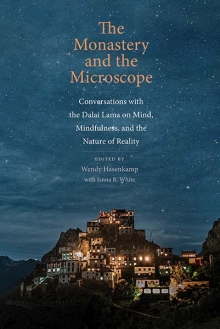How Do We Know What’s True?
Janna R. White & Wendy Hasenkamp—
In May 2016 the Wall Street Journal published an interactive online tool called “Blue Feed, Red Feed” that allowed one to see the dueling social media feeds of liberal and conservative users during the run-up to the 2016 presidential election. This side-by-side comparison revealed not just the wildly different ways that two groups can interpret phenomena, but how one group could view its interpretation to be indisputable and feel justified in disparaging another group for its “alternative facts.” The issues at stake here are crucial. Are there ways for us to become more open-minded to others’ positions, to expand our capacity to productively engage with people beyond our in-group? And just how do we determine what is true?
The Western scientific method gives us a systematic way to examine problems and find solutions whose validity can be tested. We can form a hypothesis and develop an experiment to test whether it is correct. We can conduct the experiment, look at what we find, and adjust our hypothesis to accommodate what we’ve learned. Then we can try it again. There are many instruments to help us do this work, like fMRI machines to tell us what’s going on in our brains when we perform certain mental tasks, or DNA tests to determine biological kinship.
Yet this method and its instruments are difficult to apply to certain phenomena—for example, subjective human experiences. Our study of the first-person perspective is limited by the fact that we can’t look at the human experience from outside of the human experience. A psychologist can design an elegant experiment to study the human mind, but ultimately she is using her own mind to plan the experiment and interpret the results; it is impossible for her to do otherwise. And we don’t yet have instruments to show our individual experience in such a way that someone else can verify it objectively.
That’s where Tibetan Buddhism and other contemplative traditions come in, providing methods for investigating our minds and penetrating our experiences. These contemplative traditions offer us techniques for evaluating and assessing our sensory and mental phenomena, as well as a lineage of teachers whose findings offer guidance and instruction for others who follow their path. These tools can help us change the ways we identify with and relate to our thoughts and emotions.
So Western science and Tibetan Buddhism offer complementary, systematic methods for advancing human understanding. They have historically differed in their primary objects of study—fields like physics and biology looking at the external world, and Tibetan Buddhism focusing primarily on the internal world of the mind—but over the last thirty years, that has begun to change. Representatives of the two fields are coming together with increasing regularity through the work of organizations like the Mind & Life Institute, the Emory-Tibet Science Initiative, and Science for Monks as well as many research, teaching, and clinical projects to explore various ways to collaborate and benefit from one another’s methods and findings.
For example, neuroscientist and social psychologist Tania Singer has researched compassion and empathy, and integral to her work has been studying the brains and experiences of contemplative practitioners. In our book, The Monastery and the Microscope: Conversations with the Dalai Lama on Mind, Mindfulness, and the Nature of Reality, she describes how relying on the subjective experience of a highly trained meditator led her to a new understanding of empathy and compassion. As part of her research, she invited Matthieu Ricard, a Buddhist monk with substantial expertise in compassion meditation, to her lab for some initial testing. She recalls scanning his brain while he was generating the experience of loving-kindness (mettā):
I thought that he was empathizing with someone’s suffering, but the brain signal was totally different. It was stunning. It didn’t look like the hundreds of studies we’ve done on untrained brains, asking participants to empathize with the suffering of others, which always activated parts of the pain matrix. Matthieu activated networks we know to be involved in positive feelings of reward and affiliation. When he came out of the scanner I asked him, “What were you doing? Were you not suffering, not feeling the pain? The network is so different. You were activating a network we know is involved in positive emotion, warmth, affiliation.” Matthieu explained from his first-person perspective what he was feeling. He said he felt very strong warmth and concern and a strong motivation to alleviate the suffering of the other, but not necessarily pain.
Then we asked him to experience empathy for pain rather than loving-kindness and compassion. We told him, “Go back and please just have empathy—feel the suffering”. . . . When he imagines suffering and goes into an empathetic state, we can see it. This helped us to develop a model where we differentiated between the capacity for empathy and compassion.
Tania used what she saw in Matthieu’s brain, along with his own report of his subjective experience, to help design a study to see whether anyone can be trained to experience a similar state of non-referential compassion. She said, “It’s nice to have one brain like Matthieu’s, but science doesn’t believe in just one brain.” Neither does Buddhism. Like Western science, it has insisted on the replicability of findings and has continually refined its tools so that they can be used with maximum effectiveness.
When people hear about these kinds of collaborations and our book, they sometimes remark on how great it is that unlike other religions, science shows that Buddhism is true. This misses the point entirely. The goal of bringing philosophers, monks, and scientists into conversation is not to excise from Buddhism everything that doesn’t fit current scientific understanding (ideas about rebirth, for example), nor is it to convince Western science that it doesn’t need to invent new methods for studying consciousness since Buddhism already provides one.
Of course, coming to a shared conclusion can be both satisfying and productive—quantum physics seems to accord with fundamental Buddhist concepts of interdependence, for example, and the Dalai Lama has said that learning about neuroplasticity has increased his motivation to practice meditation. But more promising are the complementary perspectives that these two traditions and their interplay give us, and the emphasis they place on moving beyond the echo chamber of whatever community we inhabit, whether disciplinary, social, or geopolitical. They can help us ensure that we are using all the tools at our disposal to engage with others productively, learn as much as we can, and share our findings for the widest possible benefit.
Janna R. White is a writer and editor who specializes in Buddhist and South Asian materials. She has numerous academic volumes to her credit, including Caring Economics, which is also based on a Mind & Life dialogue.
Wendy Hasenkamp is science director at the Mind & Life Institute and teaches contemplative science at the University of Virginia. She has also developed curriculum for and taught with the Emory-Tibet Science Initiative, a program that brings science into Tibetan monasteries in India.
Further Reading
Featured photo of prayer flags via pxhere, desk photo by freddie marriage on Unsplash


























